Introducing my own research work: about dark top models
While my life still continues being very busy, things may finally even get stabler…
In the meantime, I would like to discuss one of my recent publications, available here, in which I summarize a plenary talk I have given at a conference in South Africa last December.
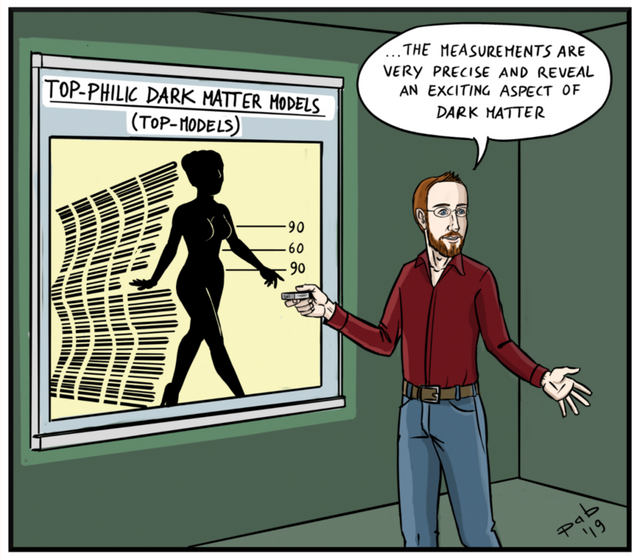
[image credits: @pab.ink]
In this work, I present some calculations achieved in the context of a class of dark matter models that could be coined the top models of dark matter.
Those models are very simple. They postulate the existence of a dark matter particle that is connected with the Standard Model through a mediator solely interacting with the top quark, the heaviest of all known particles.
In our calculations, we make use of perturbative quantum chromodynamics (the quantum theory of the strong interactions) to calculate precisely several dark matter observables in cosmology and at the LHC. And by ‘precisely’, I mean much more precisely than what is usually done. From there, we verify how viable is the model relatively to data.
More on dark top models
As a starter, let us come back to the model and the assumptions behind it. First of all, this is a model for dark matter, so that it assumes that dark matter exists.
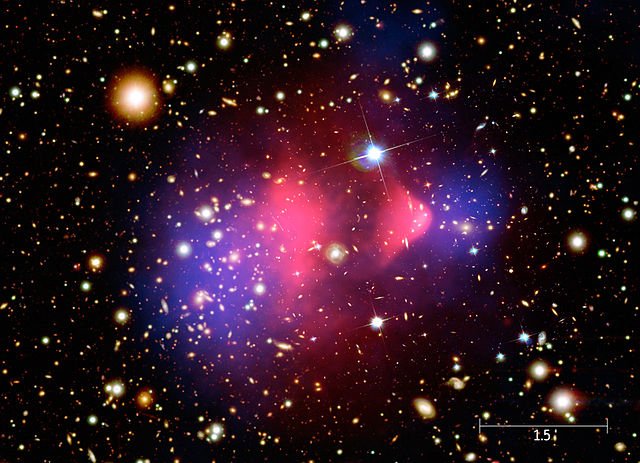
[image credits: NASA (public domain)]
This is a strong assumption, but dark matter is evidenced by many indirect observations of a different nature (while theories without dark matter are not ruled out).
Dark matter is motivated by the velocity of stars in the sky. This can only be explained (with Newton’s laws of motion) if we assume a large amount of dark matter.
Gravitational lensing, i.e. the bending of light when it travels through space, also testifies for the presence of some invisible matter. This yields duplication of images, as for instance with the Einstein cross where the same quasar is observed at different locations.
We can also mention the properties of the cosmic microwave background, a left over from the universe epoch where atoms have been formed, or the galaxy structures observed in the universe today.
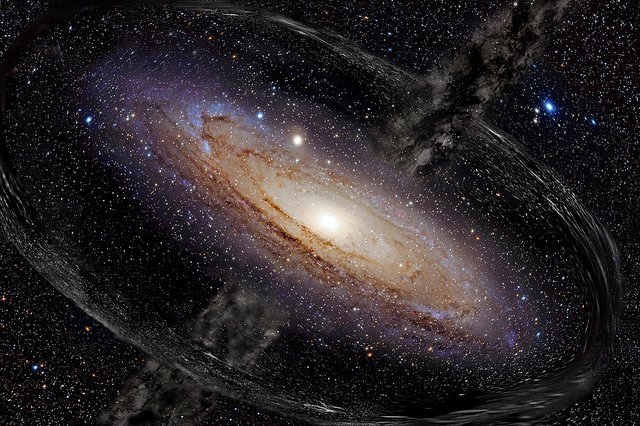
[image credits: Maxwell Hamilton (CC BY 2.0)]
In order to build a simple model for dark matter that could explain the observations, we start from the Standard Model of particle physics, and minimally add a single dark matter particle species.
In addition, we need to design the way this dark particle interacts. The easiest option is to add a second particle that will interact with dark matter and one of the Standard Model particle at the same time, the so-called mediator.
A kind a threesome option (as I discuss top models, I am allowed for the joke).
In the case of dark top models, we impose that the involved Standard Model particle is the top quark, the heaviest of all particles (and that is often considered as connected to new phenomena by virtue of its very large mass).
The relic abundance of dark matter
Observations exactly indicate the amount of dark matter present in the universe today. Therefore, we must make sure this is correctly predicted by our model. This can be calculated (more or less) very simply. We compute how dark matter annihilates and how it could be produced, and then follow the evolution of its quantity from the Big Bang until today.
This calculation (see here for more information) more or less tells us that dark matter production stops when the universe becomes too cold (the particles inside it are not energetic enough to create dark matter), and that dark matter annihilation stops when the universe has expanded too much (dark matter is too diluted to annihilate).
The results are given by the following figure.
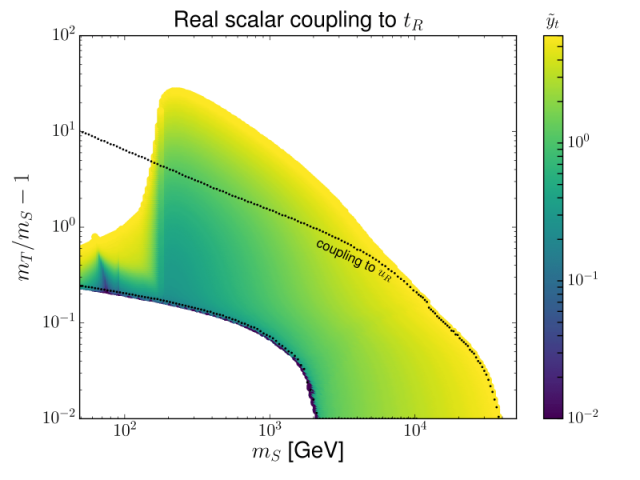
[image credits: arXiv]
In this figure, we represent the dark matter mass on the x-axis, the difference with the mediator mass on the y-axis, and the color code indicates the strength of the dark matter interaction with the top quark (yellow means very strong, and blue means weak).
The white points are configurations excluded because the predicted amount of dark matter does not match the observations. The very important novelty of our calculations concerns the right part of the figure, which could not be correctly predicted (by a factor of 1000) without relying on precision predictions.
Dark matter direct and indirect detection
Dark matter is searched for on Earth through direct detection and indirect detection experiments, as well as at colliders like the LHC.
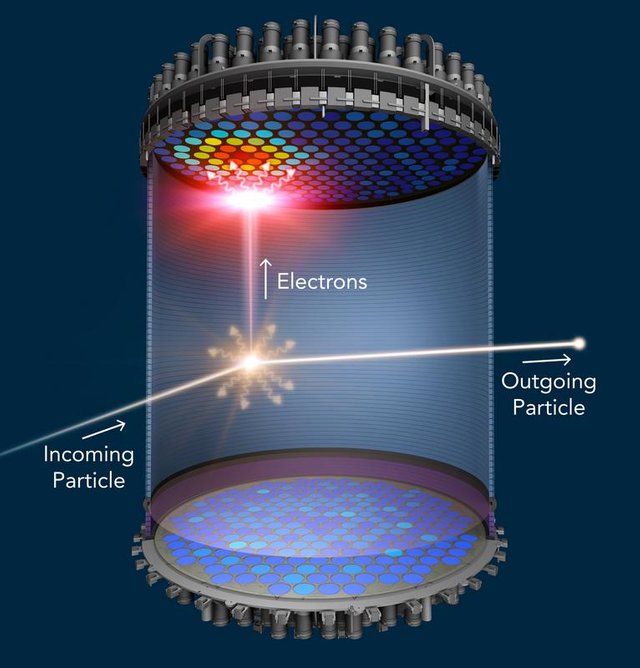
[image credits: SLAC]
In direct dark matter experiments (like Sensei which I talked about two weeks ago), we take a large detector volume and we wait for a dark matter going through it and hitting one subatomic component of the detector material.
At colliders like the LHC, we collide very energetic particles (normal matter). Thanks to the amount of available energy, this could lead to the production of dark matter (through intermediate mediators) together with some extra (normal) stuff. Whilst dark matter is invisible, the normal stuff is not. Using the conservation of energy principle, we can then unravel the invisible through the properties of the visible.
Finally, dark matter can also be indirectly detected. Dark matter may annihilate somewhere in the universe into normal matter. The products of this annihilation can then be detected on Earth, for instance in satellite experiments analyzing cosmic ray or gamma ray data.
Constraints on dark top models and take-home message
Let’s apply all the discussed constraints to our dark matter model. This gives the following figure. All our predictions are precise and include quantum effects driven by the strong interactions.
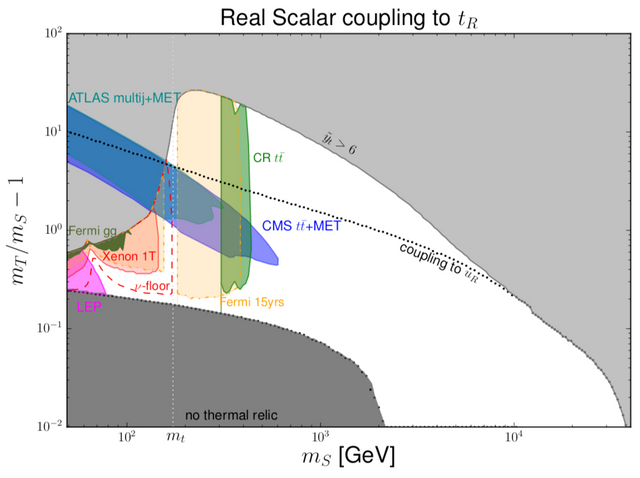
[image credits: arXiv]
In the grey area, there is no way to get the correct amount of dark matter. The different colored areas then indicate regions excluded by one or the other class of constraints, and the white area is what is viable with respect to data. The interesting point is that only future collider experiments will be able to access it.
We thus need definitely need to build the next generation of colliders to be able to fully probe the model!
SteemSTEM
SteemSTEM aims to make Steem a better place for Science, Technology, Engineering and Mathematics (STEM) and to build a science communication platform on Steem.
Make sure to follow SteemSTEM on steemstem.io, Steemit, Facebook, Twitter and Instagram to always be up-to-date on our latest news and ideas. Please also consider to support the project by supporting our witness (@stem.witness) or by delegating to @steemstem for a ROI of 65% of our curation rewards (quick delegation links: 50SP | 100SP | 500SP | 1000SP | 5000SP | 10000SP).
Made a topless version :o)
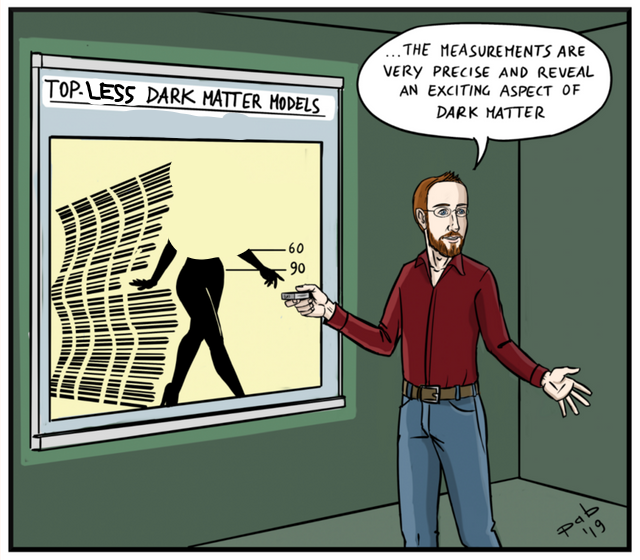
Ahaha! That is an excellent one :D
😂👍
Posted using Partiko Android
If you make all the jokes yourself, how am I supposed to comment? 😑
Do you know that when I was writing the post, I almost tagged you at this exact location :D
😃
Wow,
this is actually the hard core of science, I guess.
For me, it is sometimes hard to imagine all this stuff. For instance, is dark matter the same as antimatter? If dark matter is the consequence of colliding “real” matter, what is the matter to dark matter ratio in the universe? Recently I read that they are planning an even larger LHC. About 10 times bigger than the current LHC! What do you think? Could this project eventually disentangle this mystery?
Which book or publication would you suggest to people who are not so much into this “matter” (haha).
Thanks for the article and have a nice weekend
Regards
Chapper
Many questions in there. Let me try to answer them one by one. Feel free t come back to me on anything that would not be clear.
It is not. At the level of the fundamental particles, an antiparticle (antimatter particle) exists for all particles. For instance, we have electrons (matter) and positrons (antimatter). Quarks (matter) and antiquarks (antimatter). And so on. Both the matter and the antimatter counterparts have been observed.
For dark matter, the question becomes model dependent. There are dark matter models in which the dark matter particle is its own antiparticle (so that dark matter equals dark antimatter) and other models in which we both have dark matter particles and antiparticles.
But in all cases, we cannot really tell they are the same.
The matter to dark matter ratio is well (indirectly) measured: it is of about 5. I however do not understand what do you mean with dark matter being a consequence of colliding matter. Do you mind expanding the question a little bit? Thanks in advance!
The best is to give you this link. This is my opinion (in short: yes I would love to see this machine). I actually even co-authored the official articles where the physics potential of such a machine is discussed :D
Hey lemouth,
Thanks for the detailed reply.
In your article you write:
This implies to me that dark matter could be created solely under high energetic condition (such as at the very beginning of our universe). Or is this just an experimental setting?
Wow, pretty cool and after trying to upvote the article I realized that I got the information from this article just a few months ago.
Haha, Steemstem my new science information source.
Thanks for the explanations and good luck to get this machine funded.
Regards
Chapper
Ok now I see. We need two conditions here.
First, mass is energy. Therefore, we need to accelerate normal matter enough so that dark matter can be produced (we need enough energy to produce a heavy dark matter particle).
Second, dark matter can only be produced from normal matter if it interacts enough with it. This means, the production rate is large enough to be able to produce enough dark matter to detect it. In the model I discuss here, the mediator helps to reach a decent enough rate relstively to the LHC configuration.
Ok, understood. But where or how is dark matter produced in the universe?
The answer to there where part is easy: today, dark matter cannot be produced anymore in the universe because it is too cold. But in the early universe, the universe was much hotter so that highly-energetic normal matter particles could annihilate to produce dark matter. Today, normal particle are not energetic enough to lead to dark matter production.
For the how, it is a model dependent question. If dark matter couples to normal matter in some way, you can use this way to explain both processes: dark matter annihilation into normal matter and the reverse reaction.
Thus dark matter is diluted somehow in the universe causing the deceleration of the expansion?
The expansion of the universe is accelerating and is caused by dark energy. Dark energy and dark matter are two different objects and should not be taken one for another (I assumed you confused the two concepts here).
My son is a dark matter skeptic. You make a persuasive case--I don't know enough to have an opinion--but I can follow your discussion. I'm going to share this with my son. No doubt he will come back with a rebuttal and will find support for that rebuttal in the quote above.
As I read your piece I thought of the hunt for support of the double helix theory, and the Gosling/Franklin Photo 51. Am I correct in believing you are searching for the Photo 51 of dark matter, and that perhaps a better collider will get you there?
Intriguing discussion, which leaves room I think for generations of science fiction writers (and poets) to blossom.
Being sceptic is a healthy behavior. As we have not directly observed dark matter, alternatives are still viable. For instance, modified gravity theories are not excluded. They however, IMO, do not describe data as well as dark matter. To make a long story short, we need more observations to be able to cast any conclusive statement here.
We have many ways to get such a 'photo 51'. Colliders could being one, but dark matter direct detection experiments could provide another one. The good thing is that these two are completely independent experiments so that getting a compatible signals in both will be a strong sign of something.
Great work as always. Really goes to show you how much we have learned about the universe compared to our ancestors. One could only guess what we would know a few thousand years into the future. Even the discovery of cosmic rays was pretty groundbreaking years ago. To think that civilizations lived for countless years without knowing of its existence
There is no need to go that far in the future. I think that the next 2-3 decades will be crucial. For instance, dark matter direct detection experiments will reach the limit in which the neutrino background will forbid to see anything in typical mass ranges of the weak boson masses. The LHC will have delivered all its data. And so on. It is really an exciting time to be around today.
Does this have anything to do with the "warm-hot intergalactic medium"? I once heard about this; can't remember though.
I never knew Dark matter can annihilate into normal matter... can this be the reason it has not been discovered yet.
One more silly question: At the point of annihilation, can it be referred to as "Hot Dark Matter"?
Nice piece sir
In the same way you can collider normal matter at colliders to produce dark matter, the same reaction can be inverted: dark matter can annihilate back into normal matter. This normal matter then radiates, which gives some extra cosmic or gamma rays that can be detected on Earth.
This is not connected to the warm-hot galactic medium that is solely made of normal matter and not dark matter.
Dark matter is in principle believe to be cold (as favored by structure formation) but hot dark matter (dark matter particle with high velocities) is not totally excluded. It can be present, only if other cold dark matter particles pervade the universe.
Hey @lemouth just caught up with this article and your last one on Sensei. Great work and let's hope we get a positive direct detection of dark matter soon!
I really hope so too! :)
I'm definitely rooting for this research too after reading so many of your posts. What's your reaction going to be if you're the first scientist to detect it?
I won't be such a scientist because I am a theorist. This means that I use data once it is released by the experimenters. I the see how models can be accommodated (or not) with respect to the reinterpretation, and what we have learned on physics beyond the Standard Model in general.
To make a long story shirt, there will always be another scientist (or a collaboration of scientists) to discover something before the news gets to me so taht I could use it for my research.
Interesting as always even though this one is quite tough.
Research in the DM field is there to stay for a long time it seems.
Thanks for sharing.
Posted using Partiko Android
I would not say that long. We will learn and lot in the next 20-30 years, as said in the answer to @theabsolute and we will probably be able to make conclusive statements on many of the standard paradigms.
ahahah I love the image!
Me too! I will definitely reuse it in the next talk I will hold on the topic :)
C'est pour quand les visites de labos ? :)
Quand tu veux. Fais-moi signe quand tu es dans le coin :)